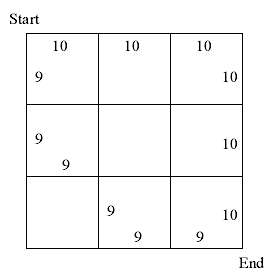 Рабочее место участника
Рабочее место участника
| Выбрать соревнование | Задачи | Послать решение | Результаты проверки | Статистика по задачам | Вопросы и ответы | Результаты соревнования | Состояние сервера | Изменить данные | Управление командой | Помощь |
 Задачи
Задачи
860. Steam Roller Кратчайшие пути из одной вершины
Кратчайшие пути из одной вершиныОлимпиадные задачи на английском языке

| 16/04/2008 | Занятие 21 (K) |
Ограничения: время – 3s/6s, память – 64MiB Ввод: input.txt или стандартный ввод Вывод: output.txt или стандартный вывод 
Послать решение Blockly Посылки Темы Где Обсудить (0)
Johnny drives a steam roller, which like all steam rollers is slow and takes a relatively long time to start moving,
change direction, and brake to a full stop. Johnny has just finished his day's work and is driving his steam roller
home to see his wife. Your task is to find the fastest path for him and his steam roller.
The city where Johnny lives has a regular structure (the streets form an orthogonal system). The city streets are laid
out on a rectangular grid of intersections. Each intersection is connected to its neighbors (up to four of them) by a
street. Each street is exactly one block long. When Johnny enters a street, he must always travel to the other end
(continue to the next intersection). From that point, he can continue in any of the four possible directions to another
intersection, and so on.
By studying the road conditions of the streets, Johnny has calculated the time needed to go from one end to the other
of every street in town. The time is the same for both directions. However, Johnny's calculations hold only under the
ideal condition that the steam roller is already in motion when it enters a street and does not need to accelerate or
brake. Whenever the steam roller changes direction at a intersection directly before or after a street, the estimated
ideal time for that street must be doubled. The same holds if the roller begins moving from a full stop (for example at
the beginning of Johnny's trip) or comes to a full stop (for example at the end of his trip).
The following picture shows an example. The numbers show the "ideal" times needed to drive through the
corresponding streets. Streets with missing numbers are unusable for steam rollers. Johnny wants to go from the top-
left corner to the bottom-right one.

The path consisting of streets labeled with 9's seems to be faster at the first sight. However, due to the braking and
accelerating restrictions, it takes double the estimated time for every street on the path, making the total time 108.
The path along the streets labeled with 10's is faster because Johnny can drive two of the streets at the full speed,
giving a total time of 100.
Input
The input consists of several test cases. Each test case starts with six positive integer numbers: `R`, `C`, `r_1`, `c_1`, `r_2`, and `c_2`.
`R` and `C` describe the size of the city, `r_1`, `c_1` are the starting coordinates, and `r_2`, `c_2` are the coordinates of Johnny's
home. The starting coordinates are different from the coordinates of Johnny's home. The numbers satisfy the
following condition: `1\ ≤\ r_1,\ r_2\ ≤\ R\ ≤\ 100`, `1\ ≤\ c_1,\ c_2\ ≤\ C\ ≤\ 100`.
After the six numbers, there are `C-1` non-negative integers describing the time needed to drive on streets between
intersections (1,1) and (1,2), (1,2) and (1,3), (1,3) and (1,4), and so on. Then there are `C` non-negative integers
describing the time need to drive on streets between intersections (1,1) and (2,1), (1,2) and (2,2), and so on. After
that, another `C\ -\ 1` non-negative integers describe the next row of streets across the width of the city. The input
continues in this way to describe all streets in the city. Each integer specifies the time needed to drive through the
corresponding street (not higher than 10000), provided the steam roller proceeds straight through without starting,
stopping, or turning at either end of the street. If any combination of one or more of these events occurs, the time is
multiplied by two. Any of these integers may be zero, in which case the corresponding street cannot be used at all.
The last test case is followed by six zeroes.
All numbers are separated with at least one whitespace character (space, tab, or newline), but any amount of
additional whitespace (including empty lines) may be present to improve readability.
Output
For each test case, print the case number (beginning with 1) followed by the minimal time needed to go from
intersection `x_1`, `y_1` to `x_2`, `y_2`. If the trip cannot be accomplished (due to unusable streets), print the word "Impossible"
instead.
Sample Input
4 4 1 1 4 4 10 10 10 9 0 0 10 0 0 0 9 0 0 10 9 0 0 0 9 0 10 0 9 9 2 2 1 1 2 2 0 1 1 0 0 0 0 0 0 0
Output for the Sample Input
Case 1: 100 Case 2: Impossible
 Начало
Начало